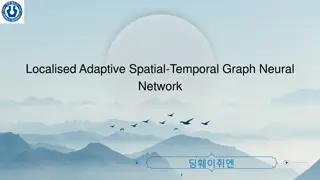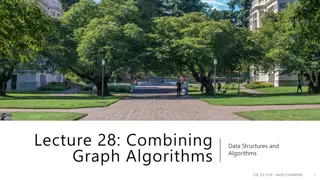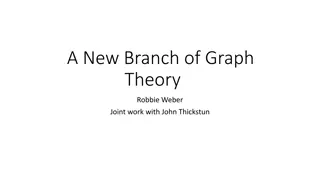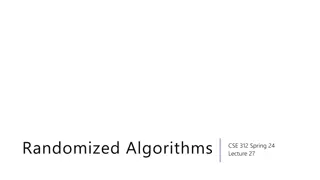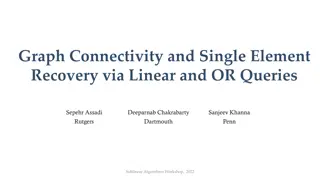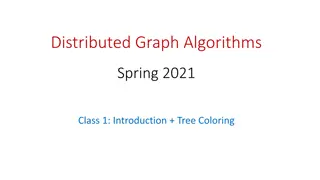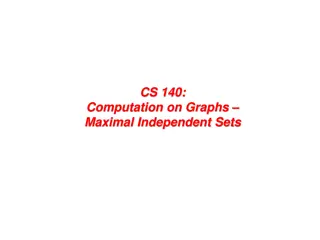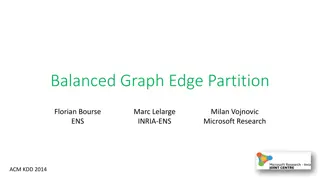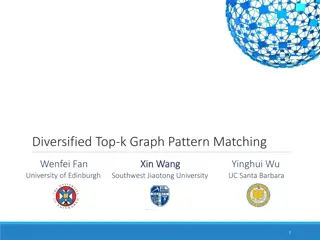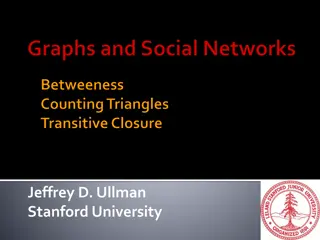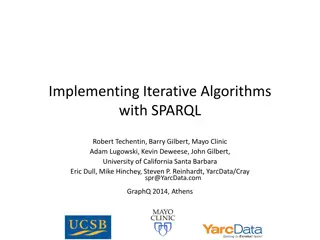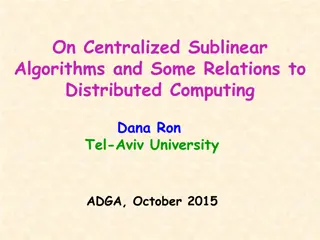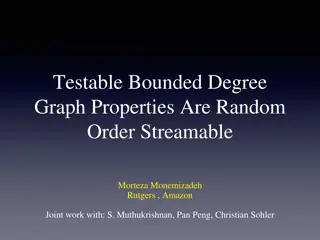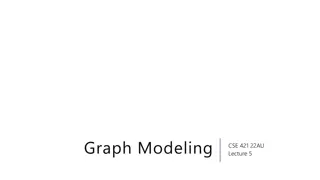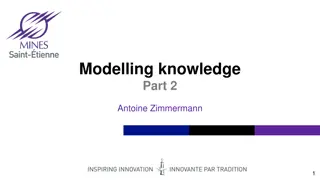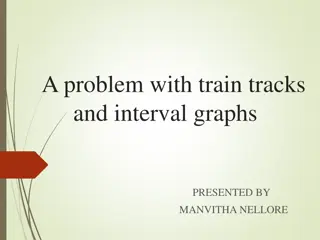Graph Exploration Concepts and Algorithms
In this presentation, various graph exploration strategies and terminologies are discussed, including BFS running time, BFS properties, DFS for directed graphs, DFS edge classification, and detailed DFS examples. The content delves into the characteristics and processes involved in breadth-first search and depth-first search, shedding light on vertex coloring, tree edges, ancestor-descendant relationships, and edge types. With insightful visuals and explanations, this resource offers a comprehensive overview of graph exploration techniques and their applications.
Download Presentation

Please find below an Image/Link to download the presentation.
The content on the website is provided AS IS for your information and personal use only. It may not be sold, licensed, or shared on other websites without obtaining consent from the author.If you encounter any issues during the download, it is possible that the publisher has removed the file from their server.
You are allowed to download the files provided on this website for personal or commercial use, subject to the condition that they are used lawfully. All files are the property of their respective owners.
The content on the website is provided AS IS for your information and personal use only. It may not be sold, licensed, or shared on other websites without obtaining consent from the author.
E N D
Presentation Transcript
More Graphs COL 106 Slides from Naveen
Some Terminology for Graph Search A vertex is white if it is undiscovered A vertex is gray if it has been discovered but not all of its edges have been discovered A vertex is black after all of its adjacent vertices have been discovered (the adj. list was examined completely)
BFS Running Time Given a graph G = (V,E) Vertices are enqueued if their color is white. Once enqueued their color is set to grey. Assuming that en- and dequeuing takes O(1) time the total cost of this operation is O(V) Adjacency list of a vertex is scanned when the vertex is dequeued The sum of the lengths of all lists is (E). Consequently, O(E) time is spent on scanning them Initializing the algorithm takes O(V) Total running time O(V+E) (linear in the size of the adjacency list representation of G)
BFS Properties Given a graph G = (V,E), BFS discovers all vertices reachable from a source vertex s It computes the shortest distance to all reachable vertices It computes a breadth-first tree that contains all such reachable vertices For any vertex v reachable from s, the path in the breadth first tree from s to v, corresponds to a shortest path in G
DFS For Directed Graphs Init all vertices Visit all children recursively
DFS Edge Classification Ancestor(u):Ancestor of a vertex u is any vertex that lies above u on the path between u and the root (including the root). Descendant(u): Descendant of a vertex u is any vertex that lies below u on a path from u down to a leaf. Tree Edge: edges which belong to the spanning tree Forward Edge: edges which connect node to descendent Back Edge: edges which connect node to ancestor Cross Edge: (u,v) is a cross edge if neither v is a descendant of u nor u is a descendant of v .
DFS Example u 1/ v w u 1/ v w u 1/ v w 2/ 2/ 3/ x y z x y z x y z u 1/ v w u 1/ v w u 1/ v w 2/ 2/ 2/ B B 4/ 3/ 4/ 3/ 4/5 3/ x y z x y z x y z
DFS Example (2) u 1/ v w u 1/ v w u 1/ v w 2/ 2/7 2/7 B B B F 4/5 3/6 4/5 3/6 4/5 3/6 x y z x y z x y z u 1/8 v w u 1/8 v w 9/ u 1/8 v w 9/ 2/7 2/7 2/7 C B B B F F F 4/5 3/6 4/5 3/6 4/5 3/6 x y z x y z x y z
DFS Example (3) u 1/8 v w 9/ u 1/8 v w 9/ u 1/8 v w 9/ 2/7 2/7 2/7 C C C B B B F F F 4/5 3/6 10/ 4/5 3/6 10/ 4/5 3/6 10/11 B B x y z x y z x y z u 1/8 v w 2/7 9/12 C B F 4/5 3/6 10/11 B x y z
DFS Edge Classification Tree edge (gray to white) encounter new vertices (white) Back edge (gray to gray) from descendant to ancestor
DFS Edge Classification (2) Forward edge (gray to black) from ancestor to descendant Cross edge (gray to black) remainder between trees or subtrees
DFS Edge Classification (3) Tree and back edges are important Most algorithms do not distinguish between forward and cross edges
DFS Algorithm When DFS returns, every vertex u is assigned a discovery time d[u], and a finishing time f[u] Running time DFS-Visit is called once for every vertex its only invoked on white vertices, and paints the vertex gray immediately for each DFS-visit a loop interates over all Adj[v] the loops in DFS take time (V) each, excluding the time to execute DFS-Visit the total cost for DFS-Visit is (E) = [ ] ( ) E Adj v the running time of DFS is (V+E) v V
DFS Timestamping The DFS algorithm maintains a monotonically increasing global clock discovery time d[u] and finishing time f[u] For every vertex u, the inequality d[u] < f[u] must hold
DFS Timestamping Vertex u is white before time d[u] gray between time d[u] and time f[u], and black thereafter Notice the structure througout the algorithm. gray vertices form a linear chain correponds to a stack of vertices that have not been exhaustively explored (DFS-Visit started but not yet finished)
DFS Parenthesis Theorem Discovery and finish times have parenthesis structure represent discovery of u with left parenthesis "(u" represent finishin of u with right parenthesis "u)" history of discoveries and finishings makes a well-formed expression (parenthesis are properly nested) Intuition for proof: any two intervals are either disjoint or enclosed Overlaping intervals would mean finishing ancestor, before finishing descendant or starting descendant without starting ancestor
Directed Acyclic Graphs A DAG is a directed graph with no cycles Often used to indicate precedences among events, i.e., event a must happen before b An example would be a parallel code execution Total order can be introduced using Topological Sorting
DAG Theorem A directed graph G is acyclic if and only if a DFS of G yields no back edges. Proof: suppose there is a back edge (u,v);v is an ancestor of u . Thus, there is a path from v to u in G and (u,v) completes the cycle suppose there is a cycle c; let v be the first vertex in c to be discovered and u is a predecessor of v in c. Upon discovering v the whole cycle from v to u is white We must visit all nodes reachable on this white path before return, i.e., vertex u becomes a descendant of v Thus, (u,v) is a back edge Thus, we can verify a DAG using DFS!
Recall : Topological Sort Precedence relations: an edge from x to y means one must be done with x before one can do y Intuition: can schedule task only when all of its subtasks have been scheduled A topological sort of a DAG is a linear ordering of all its vertices such that for any edge (u,v) in the DAG, u appears before v in the ordering
Topological Sort of DAG The following algorithm topologically sorts a DAG Topological-Sort(G) 1) call DFS(G) to compute finishing times f[v] for each vertex v 2) as each vertex is finished, insert it onto the front of a linked list 3) return the linked list of vertices The linked lists comprises a total ordering Note, larger finishing time appears earlier
Topological Sort Correctness Claim: for a DAG, an edge When (u,v) explored, u is gray. We can distinguish three cases v = gray (u,v) = back edge (cycle, contradiction) v = white v becomes descendant of u v will be finished before u f[v] < f[u] v = black v is already finished f[v] < f[u] The definition of topological sort is satisfied ( , ) u v [ ] f u [ ] f v E
Topological Sort Running time depth-first search: O(V+E) time insert each of the |V| vertices to the front of the linked list: O(1) per insertion Thus the total running time is O(V+E)



